Abstract
In vivo and in vitro studies of granulocyte chemotaxis were performed in three patients with the Chediak-Higashi syndrome. Rebuck skin windows showed a decreased accumulation of leukocytes at an inflammatory site. Studies in Boyden chambers documented a cellular defect in granulocyte chemotaxis. The chemotactic response of Chediak-Higashi cells by this technique averaged approximately 40% of normal and was consistently reduced using several different chemotactic stimuli. This deficit was magnified by shortening the chamber incubation time or by decreasing the pore size of the micropore filter and was independent of granulocytopenia. No abnormalities of passive motility, adhesiveness, viability, or pH optimum for migration were found in these cells. Chediak-Higashi serum contained no inhibitors of chemotaxis and was capable of generating normal amounts of chemotactic factors with the exception of one patient with the accelerated phase of the disease. Heterozygotes for the Chediak-Higashi trait had normal chemotactic function. This cellular defect in chemotaxis may contribute to the marked susceptibility to pyogenic infections which is so characteristic of patients with the Chediak-Higashi syndrome.
Full text
PDF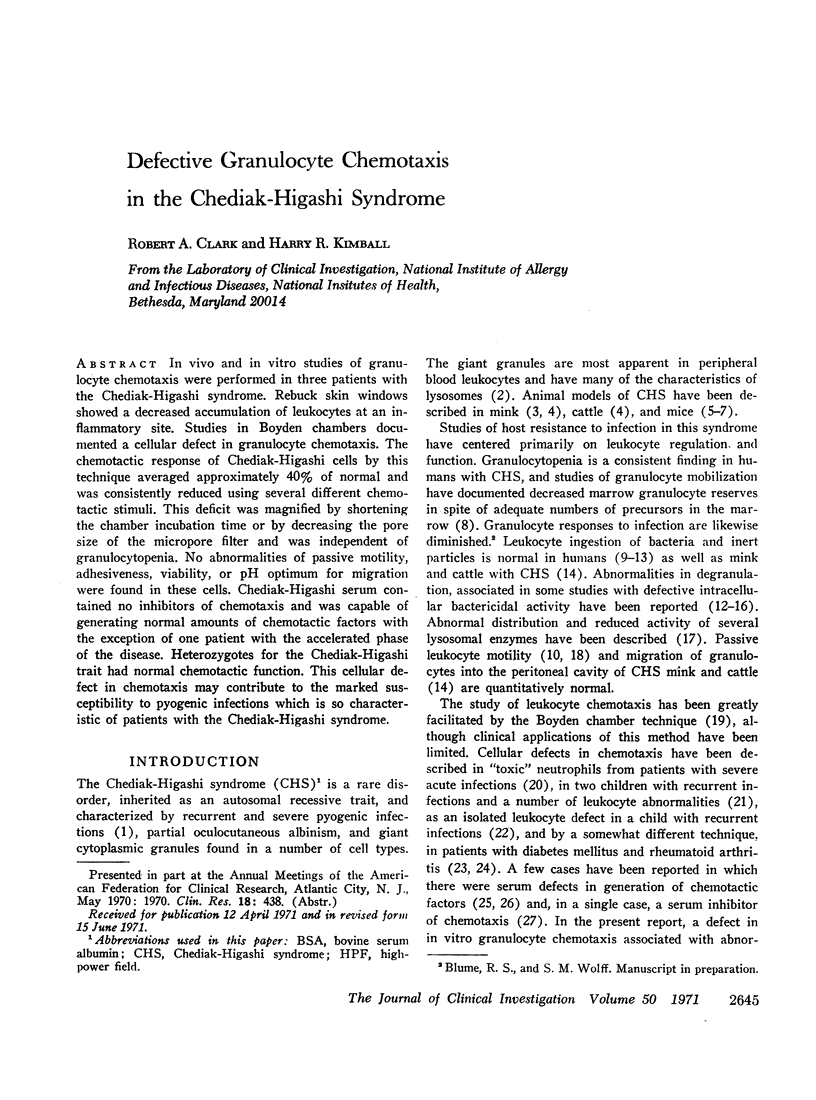
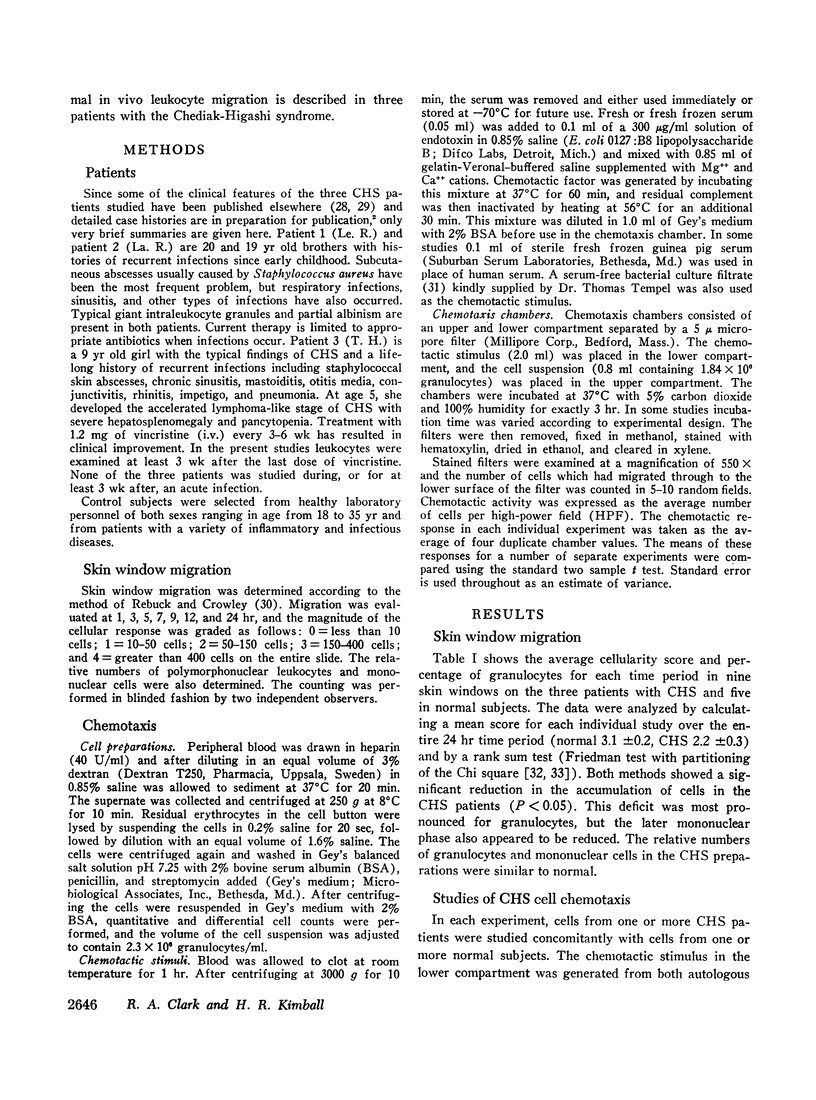
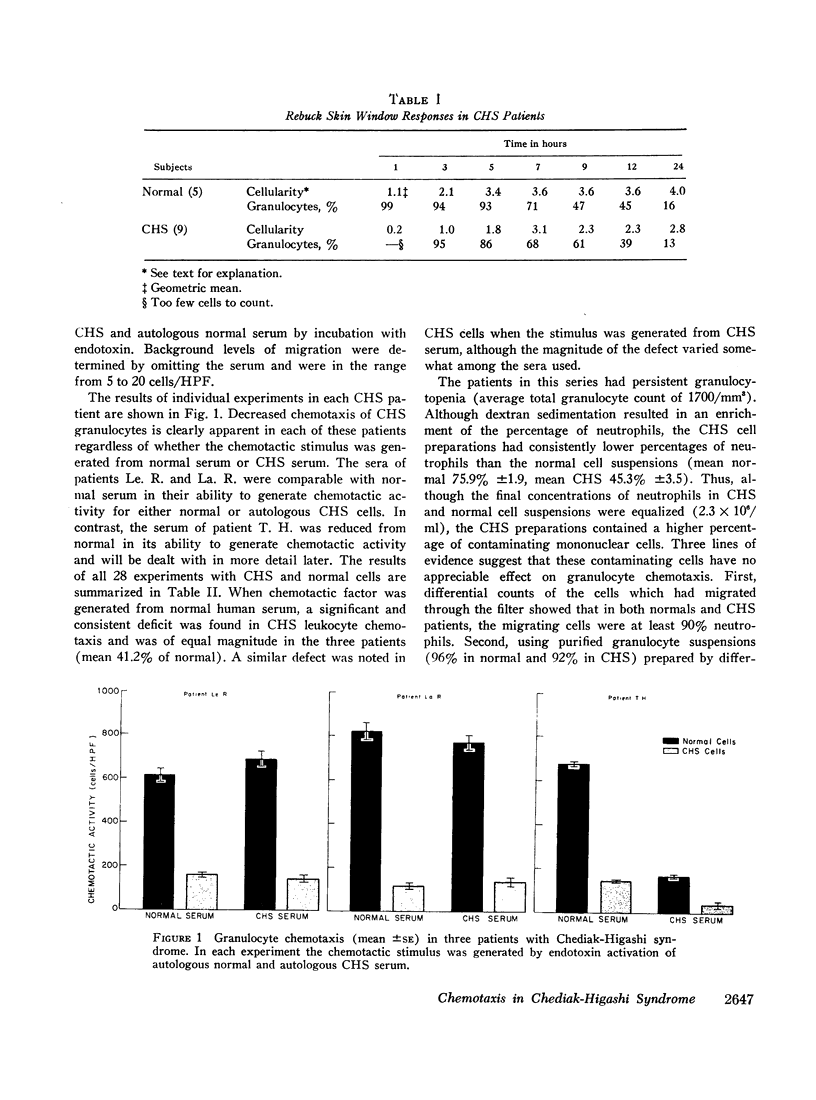
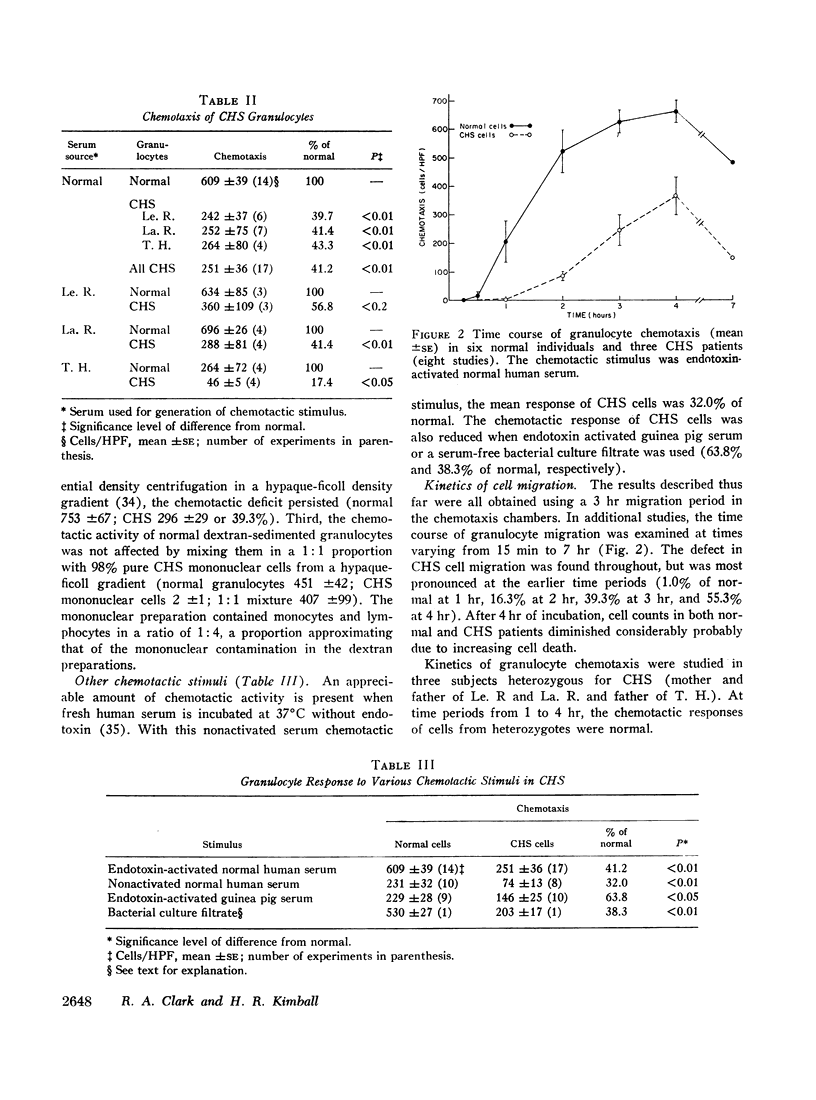
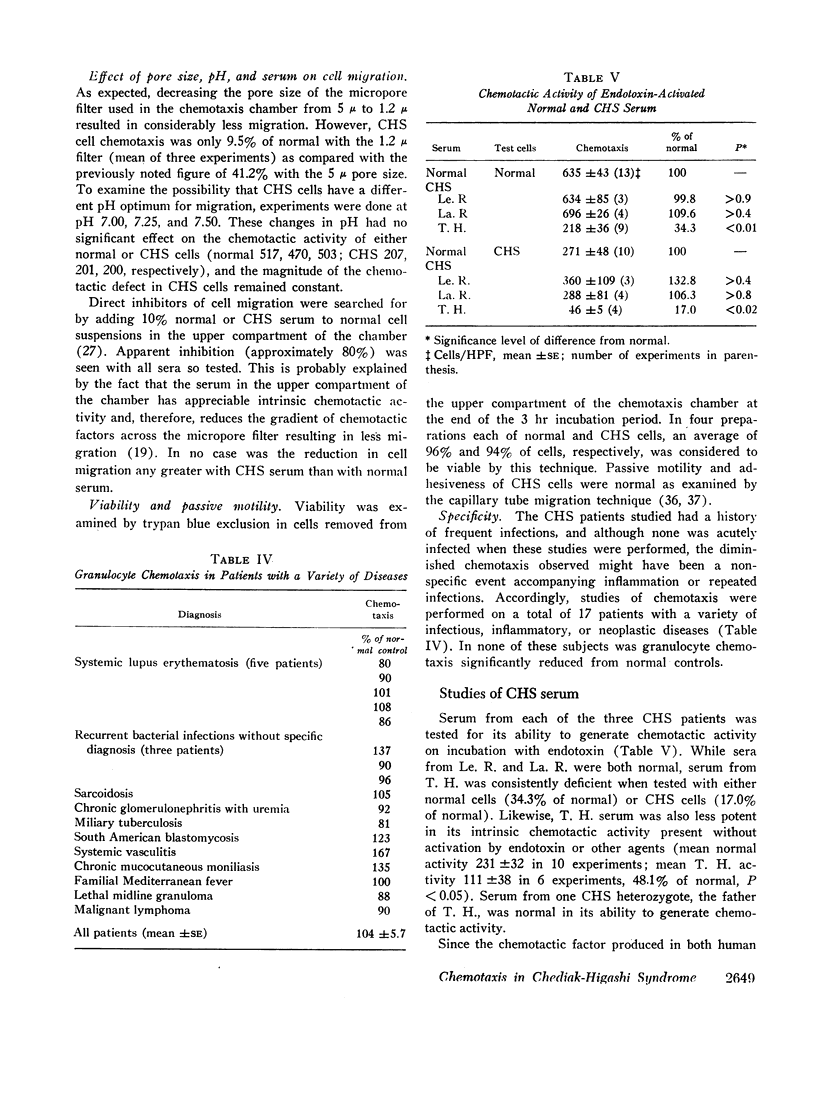
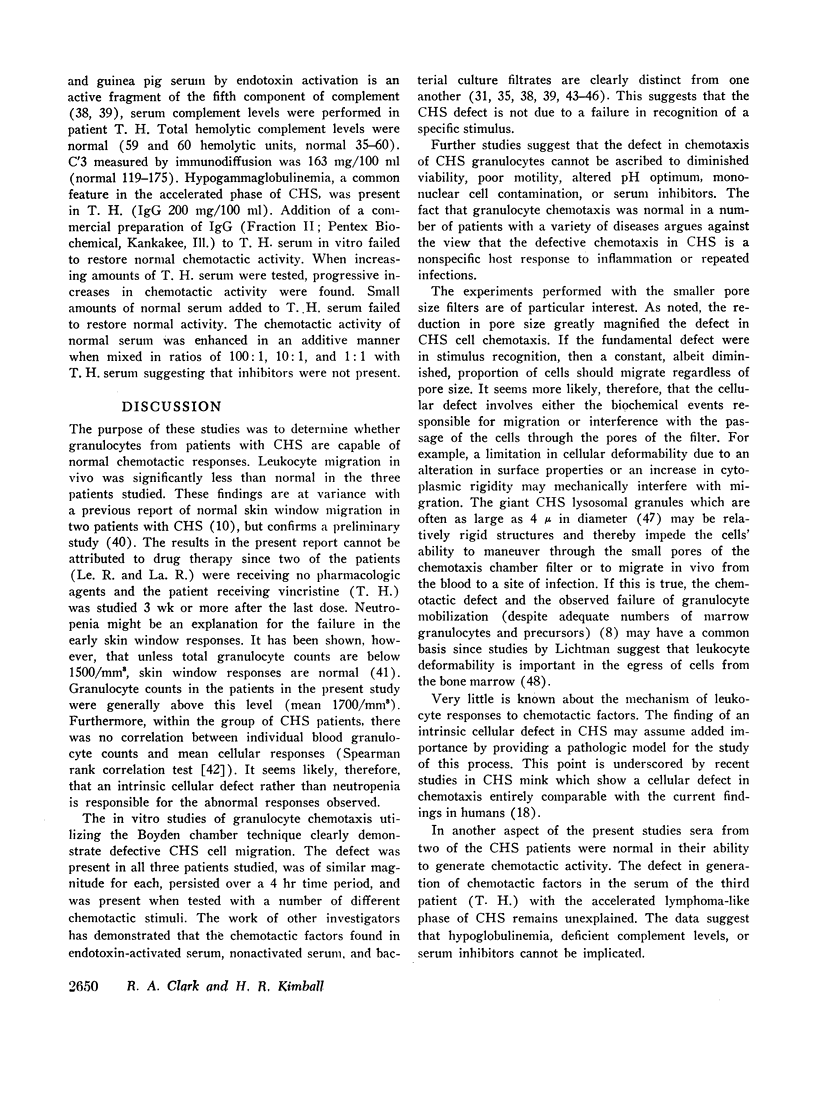
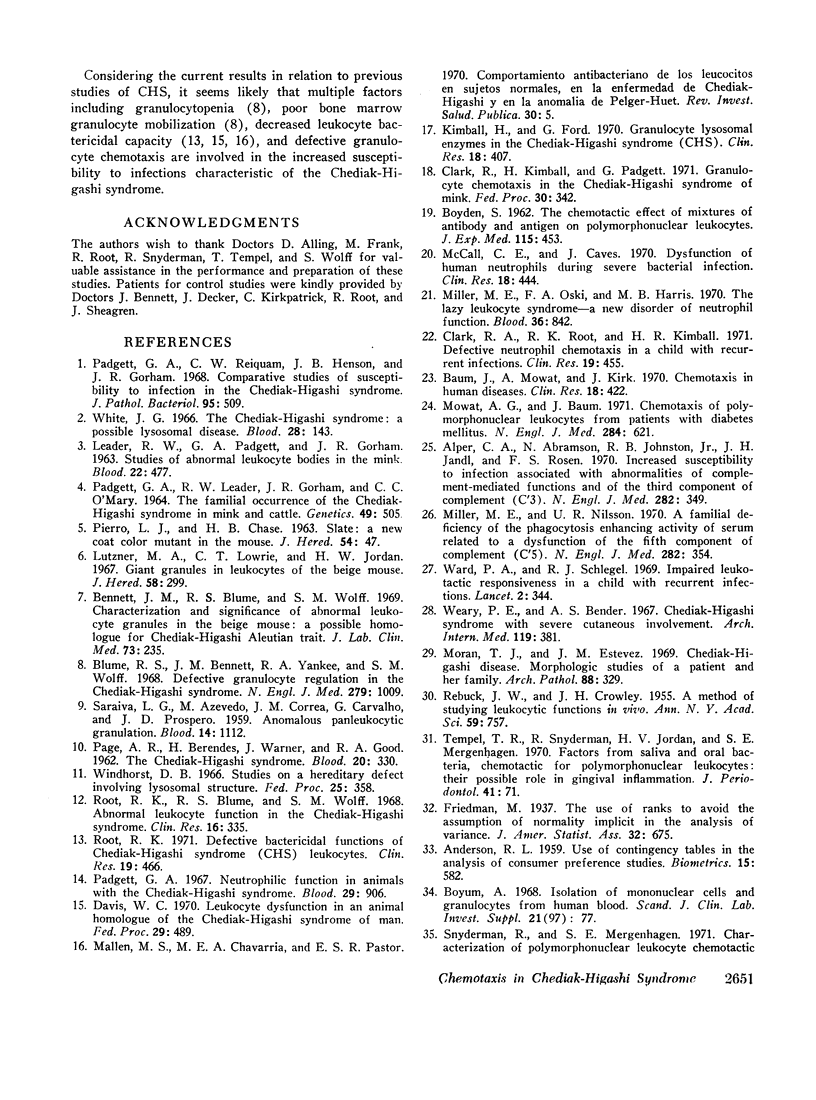
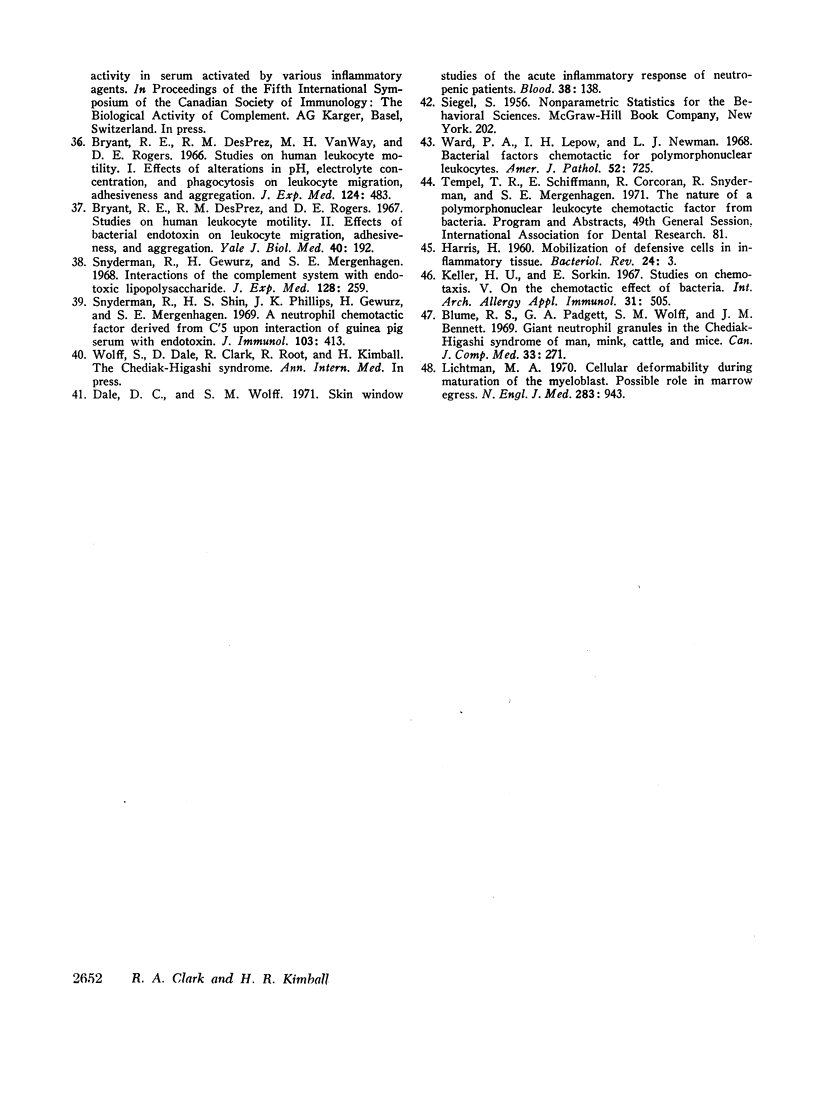
Images in this article
Selected References
These references are in PubMed. This may not be the complete list of references from this article.
- BOYDEN S. The chemotactic effect of mixtures of antibody and antigen on polymorphonuclear leucocytes. J Exp Med. 1962 Mar 1;115:453–466. doi: 10.1084/jem.115.3.453. [DOI] [PMC free article] [PubMed] [Google Scholar]
- Bennett J. M., Blume R. S., Wolff S. M. Characterization and significance of abnormal leukocyte granules in the beige mouse: a possible homologue for Chediak-Higashi Aleutian trait. J Lab Clin Med. 1969 Feb;73(2):235–243. [PubMed] [Google Scholar]
- Blume R. S., Bennett J. M., Yankee R. A., Wolff S. M. Defective granulocyte regulation in the Chediak-Higashi syndrome. N Engl J Med. 1968 Nov 7;279(19):1009–1015. doi: 10.1056/NEJM196811072791901. [DOI] [PubMed] [Google Scholar]
- Blume R. S., Padgett G. A., Wolff S. M., Bennett J. M. Giant neutrophil granules in the Chediak-Higashi syndrome of man, mink, cattle and mice. Can J Comp Med. 1969 Oct;33(4):271–274. [PMC free article] [PubMed] [Google Scholar]
- Bryant R. E., Des Prez R. M., Rogers D. E. Studies on human leukocyte motility. II. Effects of bacterial endotoxin on leukocyte migration, adhesiveness, and aggregation. Yale J Biol Med. 1967 Dec;40(3):192–204. [PMC free article] [PubMed] [Google Scholar]
- Bryant R. E., DesPrez R. M., VanWay M. H., Rogers D. E. Studies on human leukocyte motility. I. Effects of alterations in pH, electrolyte concentration, and phagocytosis on leukocyte migration, adhesiveness, and aggregation. J Exp Med. 1966 Sep 1;124(3):483–499. doi: 10.1084/jem.124.3.483. [DOI] [PMC free article] [PubMed] [Google Scholar]
- Böyum A. Isolation of mononuclear cells and granulocytes from human blood. Isolation of monuclear cells by one centrifugation, and of granulocytes by combining centrifugation and sedimentation at 1 g. Scand J Clin Lab Invest Suppl. 1968;97:77–89. [PubMed] [Google Scholar]
- Dale D. C., Wolff S. M. Skin window studies of the acute inflammatory responses of neutropenic patients. Blood. 1971 Aug;38(2):138–142. [PubMed] [Google Scholar]
- HARRIS H. Mobilization of defensive cells in inflammatory tissue. Bacteriol Rev. 1960 Mar;24(1):3–15. doi: 10.1128/br.24.1.3-15.1960. [DOI] [PMC free article] [PubMed] [Google Scholar]
- LEADER R. W., PADGETT G. A., GORHAM J. R. STUDIES OF ABNORMAL LEUKOCYTE BODIES IN THE MINK. Blood. 1963 Oct;22:477–484. [PubMed] [Google Scholar]
- Lichtman M. A. Cellular deformability during maturation of the myeloblast. Possible role in marrow egress. N Engl J Med. 1970 Oct 29;283(18):943–948. doi: 10.1056/NEJM197010292831801. [DOI] [PubMed] [Google Scholar]
- Lutzner M. A., Lowrie C. T., Jordan H. W. Giant granules in leukocytes of the beige mouse. J Hered. 1967 Nov-Dec;58(6):299–300. doi: 10.1093/oxfordjournals.jhered.a107620. [DOI] [PubMed] [Google Scholar]
- Miller M. E., Nilsson U. R. A familial deficiency of the phagocytosis-enhancing activity of serum related to a dysfunction of the fifth component of complement (C5). N Engl J Med. 1970 Feb 12;282(7):354–358. doi: 10.1056/NEJM197002122820702. [DOI] [PubMed] [Google Scholar]
- Moran T. J., Estevez J. M. Chediak-Higashi disease. Morphologic studies of a patient and her family. Arch Pathol. 1969 Oct;88(4):329–339. [PubMed] [Google Scholar]
- Mowat A., Baum J. Chemotaxis of polymorphonuclear leukocytes from patients with diabetes mellitus. N Engl J Med. 1971 Mar 25;284(12):621–627. doi: 10.1056/NEJM197103252841201. [DOI] [PubMed] [Google Scholar]
- PADGETT G. A., LEADER R. W., GORHAM J. R., O'MARY C. C. THE FAMILIAL OCCURRENCE OF THE CHEDIAK-HIGASHI SYNDROME IN MINK AND CATTLE. Genetics. 1964 Mar;49:505–512. doi: 10.1093/genetics/49.3.505. [DOI] [PMC free article] [PubMed] [Google Scholar]
- PAGE A. R., BERENDES H., WARNER J., GOOD R. A. The Chediak-Higashi syndrome. Blood. 1962 Sep;20:330–343. [PubMed] [Google Scholar]
- PIERRO L. J., CHASE H. B. Slate--a new coat color mutant in the mouse. J Hered. 1963 Mar-Apr;54:47–50. doi: 10.1093/oxfordjournals.jhered.a107219. [DOI] [PubMed] [Google Scholar]
- Padgett G. A. Neutrophilic function in animals with the Chediak-Higashi syndrome. Blood. 1967 Jun;29(6):906–915. [PubMed] [Google Scholar]
- Padgett G. A., Reiquam C. W., Henson J. B., Gorham J. R. Comparative studies of susceptibility to infection in the Chediak-Higashi syndrome. J Pathol Bacteriol. 1968 Apr;95(2):509–522. doi: 10.1002/path.1700950224. [DOI] [PubMed] [Google Scholar]
- REBUCK J. W., CROWLEY J. H. A method of studying leukocytic functions in vivo. Ann N Y Acad Sci. 1955 Mar 24;59(5):757–805. doi: 10.1111/j.1749-6632.1955.tb45983.x. [DOI] [PubMed] [Google Scholar]
- SARAIVA L. G., AZEVEDO M., CORREA J. M., CARVALHO G., PROSPERO J. D. Anomalous panleukocytic granulation. Blood. 1959 Oct;14:1112–1127. [PubMed] [Google Scholar]
- Salazar Mallén M., Amezcua Chavarría M. E., Rivas Pástor E. S. Comportamiento antibacteriano de los leucocitos en sujetos normales, en la enfermedad de Chediak-Highashi y en la anomalia de Pelger-Huet. Rev Invest Salud Publica. 1970 Jan-Mar;30(1):5–16. [PubMed] [Google Scholar]
- Snyderman R., Gewurz H., Mergenhagen S. E. Interactions of the complement system with endotoxic lipopolysaccharide. Generation of a factor chemotactic for polymorphonuclear leukocytes. J Exp Med. 1968 Aug 1;128(2):259–275. doi: 10.1084/jem.128.2.259. [DOI] [PMC free article] [PubMed] [Google Scholar]
- Snyderman R., Shin H. S., Phillips J. K., Gewurz H., Mergenhagen S. E. A neutrophil chemotatic factor derived from C'5 upon interaction of guinea pig serum with endotoxin. J Immunol. 1969 Sep;103(3):413–422. [PubMed] [Google Scholar]
- Tempel T. R., Snyderman R., Jordan H. V., Mergenhagen S. E. Factors from saliva and oral bacteria, chemotactic for polymorphonuclear leukocytes: their possible role in gingival inflammation. J Periodontol. 1970 Feb;41(2):71–80. doi: 10.1902/jop.1970.41.2.71. [DOI] [PubMed] [Google Scholar]
- Ward P. A., Lepow I. H., Newman L. J. Bacterial factors chemotactic for polymorphonuclear leukocytes. Am J Pathol. 1968 Apr;52(4):725–736. [PMC free article] [PubMed] [Google Scholar]
- Ward P. A., Schlegel R. J. Impaired leucotactic responsiveness in a child with recurrent infections. Lancet. 1969 Aug 16;2(7616):344–347. doi: 10.1016/s0140-6736(69)92699-3. [DOI] [PubMed] [Google Scholar]
- Weary P. E., Bender A. S. Chediak-Higashi syndrome with severe cutaneous involvement. Occurrence in two brothers 14 and 15 years of age. Arch Intern Med. 1967 Apr;119(4):381–386. [PubMed] [Google Scholar]
- White J. G. The Chediak-Higashi syndrome: a possible lysosomal disease. Blood. 1966 Aug;28(2):143–156. [PubMed] [Google Scholar]



